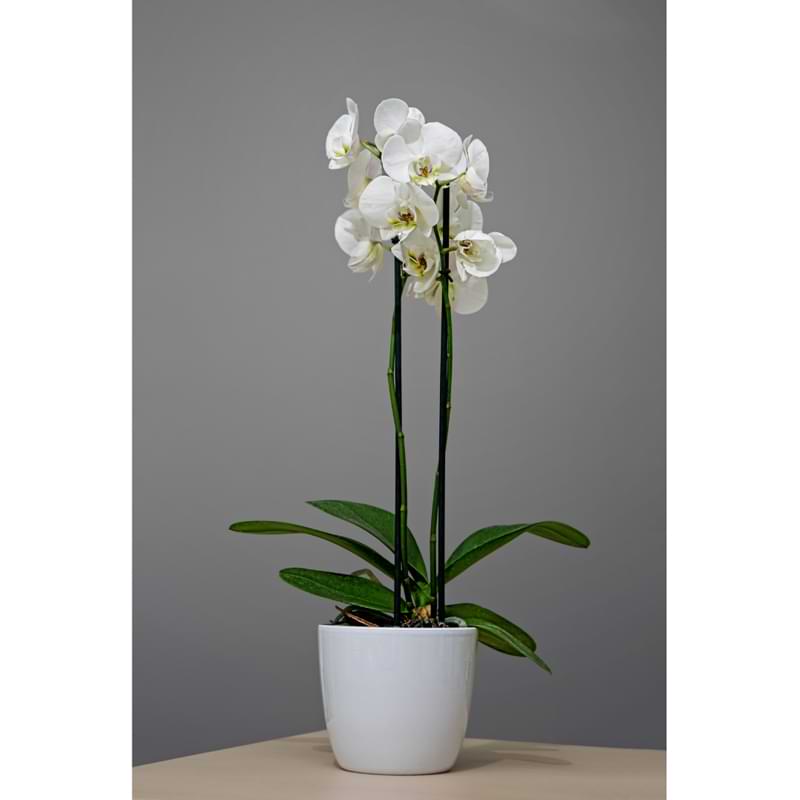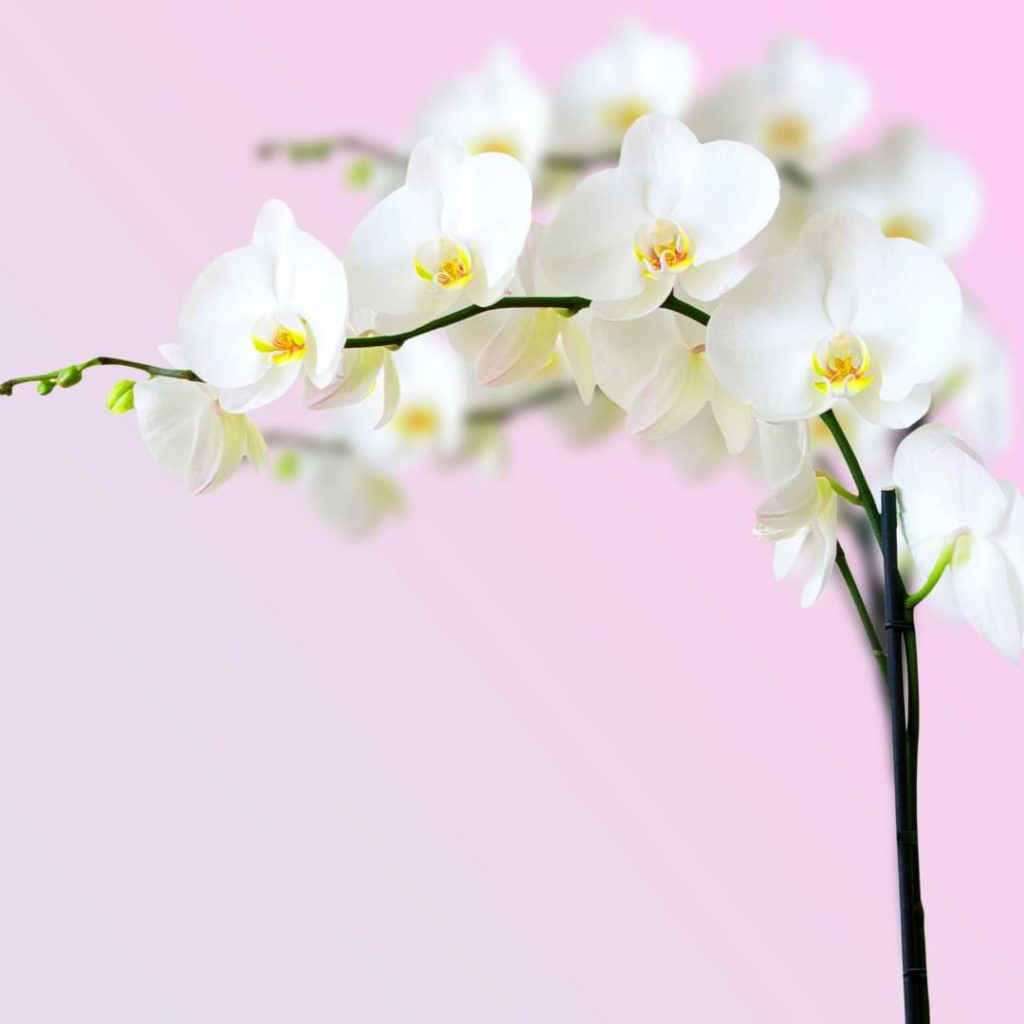The orchid’s popularity as a houseplant is based mostly on its spectacular blooms. Most orchids have long flower stems that become increasingly heavy as buds form and bloom at the top. Staking an orchid’s flower spikes can provide extra support and keep the spike from breaking. As an added bonus, staking can also allow you to position the flower spikes to give the best display of blooms.
Most houseplants don’t require stakes, so staking an orchid for the first time might seem intimidating. Don’t be afraid to try staking your orchid’s flower spikes, though. While it does require a small amount of effort and attention, the process is relatively easy. Plus, you’ll be rewarded with a beautiful display of blooms at the end.
Keep reading to find out when to begin staking orchid spikes and how to carry out the process to provide the most benefit for your orchid.
Types of Orchid Stakes
While you can use basic garden stakes for your orchids, some orchids do better with more specialized types of orchid stakes. The choices can seem overwhelming at first because there are just so many options. Here’s what you need to know.
Curved
For orchids that have arching bloom spikes, a curved stake can allow the spike to keep its natural form. You can find flexible wire stakes that have just enough give to bend into place while still supporting the orchid stem.
Plastic
Bamboo is the traditional choice for orchid stakes. However, plastic stakes have an important advantage. Unlike bamboo stakes, plastic stakes can be sterilized and used again. Bamboo stakes cannot be reused with orchids without the chance of transmitting potential disease. The decision of which one to use is up to you because both are equally good at providing support for orchid blooms.
Transparent
Most plastic stakes tend to be green, brown, or black while most bamboo stakes either retain their original color or are painted one of the three colors mentioned before. However, it is possible to use transparent acrylic stakes for your orchids.
Support Arch
Did you know that it’s possible to shape your orchid spikes into forms like waterfalls, circles, hearts, or spirals? Most orchid owners stick to more traditional shapes, but if this interests you, then give more shaping flower spikes a try. Just know that there is a risk of accidentally breaking the flower spike if you try to change its shape too quickly.
To shape an orchid spike, you’ll need a support arch. You can buy specialty support arches for different shapes. You can also use a flexible metal stake to create a support arch in the desired shape.

Do Orchids Need Stakes?
Not all orchids need stakes. Some varieties that only produce small spikes won’t benefit from the use of stakes. For other orchids, staking is helpful for two main reasons: staking supports the flower spikes and allows you to control how much space the orchid takes up.
Orchids can become top-heavy when in bloom, so the flower spikes sometimes need that extra support. Also, since orchids are grown indoors, staking can help you keep your collection under control. Depending on the space you have available in your home, you may need to use stakes to keep rogue flower spikes from going over the edge of the pot and taking up more space than you have. Phalaenopsis orchids, in particular, benefit from stakes. For other orchid species, it is not as vital to use stakes.
When to Stabilize an Orchid
Because staking can damage a flower spike if you try it too soon, it’s important to get the timing right. Wait until the flower spike is at least 6 inches long before trying to stabilize it. You don’t have to stake right away, though. You can wait until the flower spike is up to 12 inches long before beginning to stake it. Just make sure that the flower spike is still flexible and the buds have not opened yet. Once the buds open, it’s too late to change the orchid spike’s position.
Why Do Orchid Spikes Grow?
An orchid spike (also called a stem) is the part of the orchid where buds develop and turn into flowers. Orchid spikes can take anywhere from 2-3 months to grow to the stage where they will produce flowers. Some species of orchids produce leaves from nodes on flower spikes, but other species do not.
How to Identify an Orchid Spike or Stem
When a tiny green shoot emerges on your orchid, it can be difficult to tell whether you are looking at a new orchid spike or stem because new aerial roots have a similar appearance. You need to be able to tell the difference between the two because you want to stake flower spikes, not roots.
Here’s what to look for to tell the difference between orchid spikes and orchid roots.
Look for a bright green color. Orchid flower spikes usually are much greener than roots. As flower spikes grow, they keep the same green color while orchid roots tend to look less green as they get longer. Orchid flower spikes also are flatter than roots. Orchid spikes look pointy and thin while orchid roots look round and thick.
You can also watch where the shoot emerges from. Orchid spikes tend to start between the orchid’s leaves rather than from the center of the plant. As an orchid spike grows, it grows toward light while aerial roots don’t have any pattern in their growth.
Wait until the shoot is at least 6 inches long (or up to 12 inches) before staking. By this time, the difference between flower spikes and roots should be more apparent. The more time you spend taking care of your orchid, the better you’ll get at identifying the different parts.
What Happens if You Don’t Use a Stake?
If you don’t use a stake with your orchid, a few different things could happen.
In the best-case scenario, your orchid could grow just fine. Not all orchids need their flower spikes staked. If this turns out to be the case for you, then continue allowing your orchid to do its thing.
A problem that might happen if you don’t stake your orchid is that the orchid may have flower spikes and blooms that grow sideways. While this isn’t the most attractive look for orchids, flower spikes growing sideways doesn’t harm the orchid directly. The real issue is that sideways flower spikes may cause the orchid to topple over or make it more likely that you’ll accidentally bump into the orchid and damage it. Be extra careful around any orchids with off-kilter flower spikes that you weren’t able to stake early enough.

How to Keep an Orchid Upright Step by Step
Staking your orchid correctly reduces the risk of damage, especially if your orchid produces long flower spikes. Here’s how to stake a flower spike correctly.
Supplies needed:
- Stakes (one for each flower spike)
- Plastic orchid clips or twist ties (avoid using wire)
Step 1: Insert a stake into the orchid pot.
Avoid hitting the orchid roots as you push the stake into the pot. You may have to carefully move the stake around as you press it deeper. If you are able to, push the stake all the way to the bottom of the pot.
Step 2: Attach a flower spike to the stake using orchid clips or twist ties.
Start by placing a clip on the lowest node near the base of the flower spike. Use additional clips or twist ties every few inches to securely attach the spike to the stake.
Step 3: Repeat the process above for any additional flower spikes.
Different orchids have different numbers of flower spikes. Make sure to stake all the flower spikes.
Step 4: As the flower spikes grow, continue adding more clips or twist ties every few inches.
Once buds start to form, stop adding additional support. The last clip or tie should be a few inches below the first bud.
Caring for an Orchid Spike
Once your orchid spike is staked and producing flowers, the best thing to do is allow it to continue its cycle on its own. Depending on how long your orchid flowers, you should be able to enjoy blooms anywhere from 6 weeks to a few months.
If you’ve never cared for an orchid before, you might think you should get rid of an orchid after it’s finished blooming, but that isn’t the case. Orchids can bloom again once a year and sometimes more often. You just need to do a few things to care for your orchid’s spikes after the blooms are finished.
Pruning
Some orchids need to be pruned after flowering. Phalaenopsis is one orchid that should be pruned once it has finished blooming and the flowers have faded. To prune Phalaenopsis and other similar orchids, use sterilized scissors to cut flower spikes down to 1 inch. If the flower spike is brown, it’s time to cut the stalk down to the base.
Other orchids, like dendrobium orchids, don’t require extensive pruning because they bloom on the same flower spike the next year. For dendrobium and similar orchids, trim off the flowers but don’t trim the stem back.
Reflowering
Some orchids will reflower quickly while others only bloom once each year; it depends on the type of orchid you have. Phalaenopsis and vanda orchids will bloom multiple times a year given the proper conditions while other popular orchids like cattleya and cymbidium only bloom once a year. As long as you know which type of orchid you have, you can figure out if it is capable of blooming more than once a year.
To prompt orchids to rebloom after a period of dormancy, you’ll need to mimic the conditions that cause an orchid to bloom in its natural environment. For most orchids, this means they will need a period with fewer hours of light followed by a period with more hours of light. They will also likely need to go through a drop in temperature to signal that it’s time to rebloom again.
To get the conditions exactly right for your orchid to rebloom, find out what conditions trigger blooms. Then provide those conditions for your orchid.
Orchid Stakes FAQ
How many spikes do orchids have?
The majority of orchids only produce only 1 or 2 new spikes at a time. However, some species can produce as many as 3 or 4 new spikes at a time.
How long does it take for orchid spikes to grow?
Once a new orchid spike appears, it generally takes anywhere from 2 to 3 months for the spike to finish growing. The exact timing depends on the temperature and the light available for the orchid as well as the orchid species.
How long do orchids live for?
In general, you can expect an orchid to live for about 15 to 20 years if it is given the proper care. Make sure you’re regularly repotting your orchid every few years to keep it healthy and that you are providing the proper care for it to thrive.
Will an orchid bloom a second time?
Once your orchid has finished blooming, it will go through a dormant stage. It may seem like the orchid is dead during this stage, but it’s actually spending the time replacing nutrients. Once the dormancy stage has ended, your orchid will bloom again. The exact amount of time between blooms depends on the type of orchid. Some orchids can bloom multiple times a year while others can only bloom once.
Join Our Orchid Care Facebook Community
In our Facebook group of orchid lovers, we’re dedicated to creating a rich and engaging environment where plant lovers can come together and share tips, tricks, and experiences.
If you’re an orchid lover, come join our Facebook community! We can’t wait to celebrate your successes and help you troubleshoot your care routine.
For continued success, you can explore our other articles or visit our online shop for plant care products that are sure to keep your plants boasting rich green leaves and big, bountiful blooms year-round.



